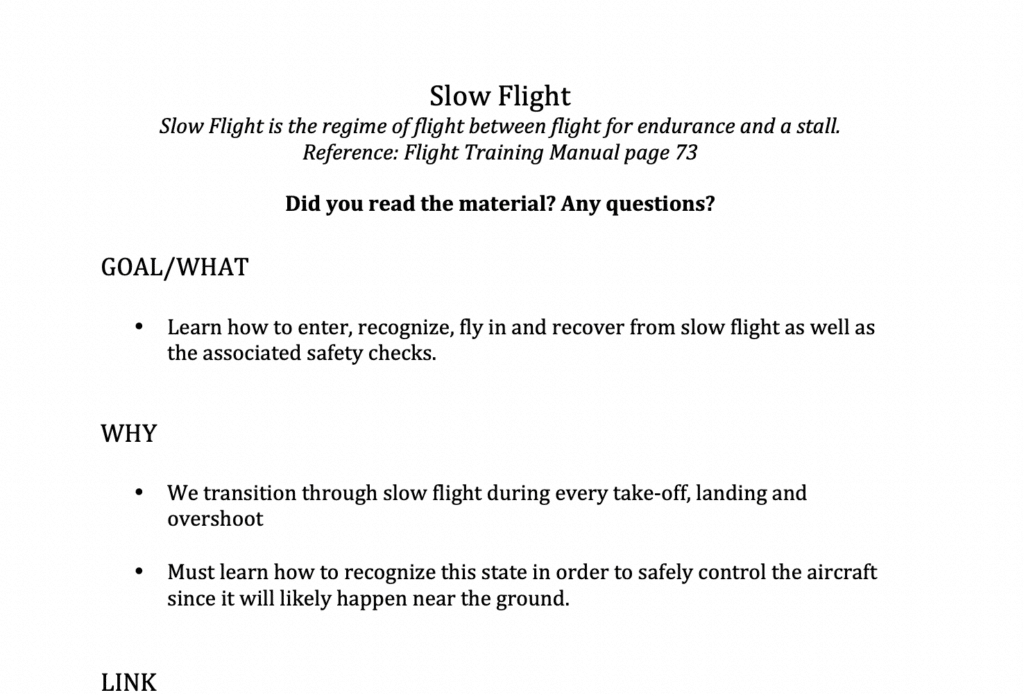Lesson Plans for PGIs
Look in the flight instructor guide and you will see there is no text on how to make lesson plans. Only guidance material saying, include this or do this to satisfy this learning factor. No templates, nothing. Here, we will go through the basic template of a PGI (preparatory ground instruction) lesson plan which will allow you to create your own, adding and changing the content of each section as it suits you.
It is common that you as a new flight instructor may receive other instructors PGIs’, which is totally fine as long as you are not actively using them for your own students. As instructors, it is our job to communicate our ideas in the best and most effective manner to our students, and the best way to do that is through our own personalized lesson plans.
If I gave you my lesson plans on stalls and a bullet point half way into the lesson just said “Critical Angle of Attack,” to me it is a whole idea in itself. To you, the substitute instructor using my notes, it might make you scratch your head.
For that reason, it is important we do not just teach using someone else’s LP and instead put in the effort to make our own. By using your own, you will use the wording you like, the template you like, the emphasis, colouring, visual aids you like which will help you make the most effective PGI presentation. It will keep you on track and make sure you don’t miss anything due to a poor memory in the moment.
Working Backwards
When making a lesson plan we need to work backwards, thinking of the topic first. Narrow it down and let’s create our objective. Ask yourself, what do you want the student to learn by the end of the lesson? To determine this we can use the Flight Instructor Guide Part II to help (link here). Once our objective is determined, ask yourself what questions can you ask the student that stem from the objective, that if answered correctly would allow them to meet the objective.
For example:
Exercise 11 Slow Flight: The objective is for the student to be able to learn the HASEL check, be able to enter, recognize, fly around and exit slow flight. Stemming from this, we need to think of questions to ask the student that if they can answer, will lead them to fulfilling it. If the student can answer the following questions, I will be sure they have fulfilled my objective:
- What is the safety check completed prior to completing slow flight?
- What is the procedure for entering slow flight?
- What controls airspeed in slow flight?
- How do we recover from slow flight?
- What is the minimum height to complete this exercise?
In order for the students to be able to answer these questions, we must teach them the answers. This content becomes the body of your lesson plan. With this, we must determine which materials are required to teach the lesson.
A HASEL CHECK:
H – Height (as appropriate per FTU)
A – Area (not built up)
S – Security (No loose maps from previous navigation etc,.)
E – Engine (Secured as required, mixture lean/rich…)
L – Lookout
The body and content is roughly the extent of the new material taught during a PGI. We must ask ourselves at this point, what does the student need to know in order to learn the main content and body of today’s lesson. This essentially becomes our Threshold Knowledge Test. More information on this is linked in the TKT article.
> What is flight for endurance?
> Which types of adverse yaw are present when I add or reduce power? What about when I raise or lower the nose?
Essentially at this point, we are to introduce the lesson to the student, motivate them to learn and tell them what the objectives of today’s lessons are.
What (Objective) – Today we are going to learn slow flight as well as the safety precautions we must take when practicing them. Slow flight is the regime of flight between a stall and flight for endurance.
Why (Rec/PPL) – We learn slow flight because we will encounter it every flight during take-off and landing. Also, the signs of slow flight will come up in later lessons like in stalls and spins.
Link/Where – We are going to build on the skills learned in exercises 6 and 10 and once we learn today’s skills, they will help us into exercise 12.
For those most part, that’s really it. Be sure to include a title of your lesson plan, write an agenda on the board or have an agenda to follow during a powerpoint presentation, and include your references for your PGI. If the content is excessive, with additional topics like “Theory (A little bit)…” or “Factors Affecting _______,” then use a break every 8-12 minutes during the content and confirm that learning has taken place before continuing on with new material.
I also write down a reminder to establish rules of the PGI, mentioning to new students my expectations during the PGI. I would tell students that they can interrupt me with questions at any time, take notes when appropriate, be open to asking me to slow down etc,.
A successful PGI presentation is self-made and complete. Do not confuse a PGI with ground school instruction or a pre-flight briefing. We are to teach the student only what they need to know for today’s flight. It is not death by briefing as it should be concise yet complete. Below is a complete PGI example for the same exercise of slow flight.
If you would like to add to the article or disagree with any content, please e-mail us using the “Contact Us” tab above. Flying and teaching is very dynamic and any input is appreciated and welcomed.
This lesson is intended for students who have completed their commercial pilot flight test and written exam. This information supplements our Commercial Pilot Ground School and is designed as a supplement to teaching. Students who are interested in pursuing an instructor rating are encouraged to connect with our instructors and arrange an information meeting free of charge.


